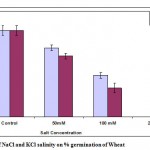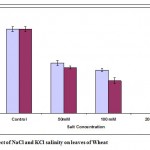Manuscript accepted on : January 28, 2009
Published online on: 28-06-2009
Wheat and Salanity: Response of Different Concentrations of Nacl nd Kcl
S. D. Taware1*, A. S. Taware2, A. M. Chavan3 and D. S. Mukadam³
1Genome Life Sciences, Labh Chambers, Station Road, Aurangabad India. 2Department of Biotechnology, MGM’s Institute of Biosciences and Technology, Aurangabad India. 3Department of Botany, Dr. Babasaheb Ambedkar Marathwada University, Aurangabad India.
ABSTRACT: This study was aimed to find out the effects of different concentrations of NaCl and KCl salts on growth and some biochemical parameters of wheat crop. In the biological growth parameters, % germination, leaves per plant and total plant height were observed. Effects of various levels of NaCl and KCl on total chlorophyll content and protein were studied. The results showed that the biological growth parameters in wheat decreased with increasing salt concentration in comparison to control. It is also observed that the biological parameters showed more adverse effect of NaCl than that of KCl. During the biochemical investigations, total chlorophyll contents in wheat showed no considerable change. But total proteins showed increase in content as with increase in concentration of NaCl and KCl. This study may be carefully considered if wheat is grown under NaCl or KCl saline soil conditions.
KEYWORDS: Wheat; NaCl; KCl; biological growth parameters; biochemical changes
Download this article as:| Copy the following to cite this article: Taware S. D, Taware A. S, Chavan A. M, Mukadam D. S. Wheat and Salanity: Response of Different Concentrations of Nacl nd Kcl. Biosci Biotechnol Res Asia 2009;6(1) |
| Copy the following to cite this URL: Taware S. D, Taware A. S, Chavan A. M, Mukadam D. S. Wheat and Salanity: Response of Different Concentrations of Nacl nd Kcl. Biosci Biotechnol Res Asia 2009;6(1) . Available from: https://www.biotech-asia.org/?p=8209 |
Introduction
In the nature, there are many abiotic factors disturbing the biological parameters of crop plants. Salt stress or the soil salinity is one of the major abiotic factor affecting crop yields in arid and semi arid irrigated areas (Szabolcs, 1989). Approximately one third of the worlds irrigated soils and large proportion of soils in dry land are saline (Carter et al., 2005).
Plants vary, however, in their ability to cope with salinity, as is evidenced by the wide diversity of plant habitats, ranging from nonsaline environments to the extreme salinities of the sea, salt marshes, and saline deserts. For crop plants, differences n salt resistance exist not only among different genera and species, but even within a species which may on the whole be considered salt sensitive (Epstein et al., 1980, Epstein, 1983).
The reduction in yield of many crops by salinity is well documented. The growth of plants may be reduced under salt stress because of an osmotic stress due to a lowering of the external water potential, or effects of specific ions on metabolic processes ranging from the absorption of nutrients to enzyme activation or inhibition (Flowers et al., 1977, Greenway, et al., 1980). Two major effects have been identified as the probable causes of high salt toxicity in crop plant i.e. the ionic effect and the osmotic effect. The ionic effect results in alterations in enzymatic processes, disturbances in accumulation and transport of different ions or a combination of all these factors. As a result, shoot and root growing reduce and uptake of nutrient elements by plants is adversely affected (Huang et al., 2005).
Soluble salts in high concentration affect the plant growth in three way; i) excess Na, Cl and B concentration causes in physiological problems; ii) destroys ionic balance of plant; iii) hinders water use of plant through decreasing water potential due to osmotic effect of these salts (Netonto et al., 2004, Huang et al., 2005).
In this research, Indian cultivar wheat variety 2189 was sown in a pot under a green house conditions to carry out the salt stress experiment. Three different concentrations of NaCl and KCl were used to observe their effect of biological growth parameters and biochemical investigations with comparison to control. The effect of application of NaCl and KCl salts in increasing doses on some biological growth parameters of wheat and biochemical changes were investigated.
Materials and Methods
Seeds of cultivated wheat (Triticum aestivum L.) genotype var. 2189 were obtained from Mahatma Phule Agricultural University, Rahuri, and taken for further research. Twenty seeds of wheat genotype 2189 were sown per pot under green house conditions with controlled temperature (22oC, ±2oC) and treated with 50mM, 100mM and 200mM concentration of NaCl and KCl each with control treated with water having neutral pH. After every 10 days, NaCl and KCl salt application was given to respective pots. Whole experiment was carried out in three replications.
Total germination percentage, total leaves per plant and total plant height was determined. Young leaf tissue were harvested from all those treatments and used for chlorophyll a, b and c estimation and total protein estimation.
Chlorophyll Estimation from Plant Leaf tissue
Total chlorophyll was estimated by using Mac Kinney (1941) protocol for absorption of light by chlorophyll solution.
Estimation of protein
Total proteins were estimated by using Bradford (1976) protocol for a rapid and sensitive method for the quantitation of microgram quantities of protein utilizing the principle of protein-dye binding.
Statistical design and analysis
In all experiments, the values were the mean of three replicates per treatment. The results were subjected to a one or two way analysis of variance with a least significant difference (LSD) test between mean values.
Result and Discussion
Effect of Salinity on Biological Growth Parameters
The effect of NaCl and KCl on germination percentage of wheat
Seed germination decreased with increasing the concentration of NaCl and KCl salt application. Control treatment showed highest germination. No germination was found in 200mM concentration of both the salts. Significant difference was obtained for salts regarding seed germination. Reduction in germination by an increase of salinity levels has been described by numerous authors (Othman et al., 2006; Breen et al., 1997). Increasing salinity concentrations in germination often cause osmotic and or specific toxicity which may reduce or retard germination percentage (Fig No. 1).
 |
Figure 1: Effect of NaCl and KCl salinity on % germination of Wheat.
|
The effect of NaCl and KCl on the number of leaves per plant of wheat: The average number of leaves per plant decreased. However when this decrease compared with the control, the number of leaf per plant decreased with increasing rate of salt application. The effect of salt application on the average number of leaf per wheat plant was found significantly effective over the control. The reason for this decrease is that the uptake of nutrient elements and water availability are limited under saline conditions (Carter et al., 2005). Further explanation for this result; destroy of ionic balance in plant with high salinity level (Huang et al., 2005) (Fig No. 2).
 |
Figure 2: Effect of NaCl and KCl salinity on leaves of Wheat.
|
The effect of NaCl and KCl on total plant height of wheat
Height of plant decreased with increasing rate of salt application. This decrease was higher in KCl than the NaCl. Significant difference in plant height was observed with both the applications of salt with comparison to control (Fige No. 2).
Effect of salinity on Biochemical components in wheat
The effect of NaCl and KCl on chlorophyll contents
It is observed that there is significantly decrease in the chlorophyll a, b, and c content with the concentration of NaCl and KCl salt application. But no any considerable difference within NaCl and KCL with increasing the concentration of salinity was observed (Table No. 1).
Table 1: The effect of NaCl and KCl on leaf chlorophyll a, b and c and total leaf protein.
| Salt | Salt Conc. | Amount of Chlorophyll a (mg/gm) | Amount of Chlorophyll b (mg/gm) | Amount of Chlorophyll (mg/gm) | Amount of Total Leaf Proteins (mg/gm) |
| NaCl | 50mM | 59.80 | 96.22 | 90.79 | 10.6 |
| 100mM | 59.75 | 100.80 | 92.83 | 10.4 | |
| KCl | 50mM | 67.34 | 102.81 | 97.34 | 8.2 |
| 100mM | 85.90 | 143.33 | 134.93 | 8.6 | |
| Control | Water | 98.60 | 142.86 | 135.75 | 7.8 |
The effect of NaCl and KCl on total leaf protein contents
Wheat plant grown under the increasing salinity of NaCl and KCL concentration showed increase in total proteins over the control. The control showed decrease in total leaf proteins while the NaCl and KCl treated plants given increase in total proteins. Investigations not showed any significant increase with the increasing concentration of NaCl and KCL applications (Table No. 1).
Conclusion
Some biological parameters of wheat plant were negatively affected by increasing concentrations of NaCl and KCl salts. Germination percentage, number of leaves per plant and total plant height were decreased when compared to controls with increasing salt concentrations. According to the biological growth index results, wheat plant was negatively affected by increasing salinity in the soil. Soil salinity should be controlled for wheat growing. NaCl and KCl compounds should be applied in the precise amount to wheat. Otherwise quantity, quality and yield of wheat plant will be decreased.
References
- Bradford M, A Rapid and sensitive method for the quantitation of microgram quantities of protein utilizing the principle of protein-dye binding, Anal Biochem, 72 (1976) 248.
- Breen C M, Everson C, and Rogers K, Ecological studies on Sporobolus virginicus (L.) Kunth with particular reference to salinity and inundation, Hydrobiologia, 54 (1997)135.
- Carter C T, Grieve C M, and Poss J A, Salinity effects on emergence, survival and ion accumulation of Limonium perezii, J Plant Nutr, 28 (2005)1243.
- Epstein E, Crops tolerant of salinity and other mineral stresses. In Better Crops for Food, Ciba Foundation Symposium No 97, Pitman Books, London, (1983) 61.
- Epstein, E, Norlyn J D, Rush D W, Kingsbury R W, Kelly D B, Cunningham G A, and Wrona A F,. Saline culture of crops: a genetic approach, Science, 210 (1980) 399.
- Flowers T J, Troke P F, and Yeo A R, The mechanism of salt tolerance in halophytes, Ann Rev Pl Physiology, 28 (1977) 89.
- Greenway, H, and Munns R, Mechanisms of salt tolerance in nonhalophytes, Ann Rev Pl Physiology, 31 (1980)149.
- Huang Y, Zhang G, Wu Y, Chen J, and Zhou M, Difference in physiological traits among salt stressed barley genotypes, Communication Soil Sci Pl Anal, 37 (2005) 557.
- Mac Kinney G, Absorbance of light by chlorophyll solutions, J Biol Chem, 140 (1941) 315.
- Netonto G W, Onyongo J C, and Beck E, Sorghum and salinity: response of growth, water relation and ion accumulation to NaCl salinity, Crop Sci, 44 (2004) 797.
- Othman Y, Karaki, G A1, Al-Tawaha A R, and Alhorani A, Variation in germination and ion uptake in barley genotypes under salinity conditions, J Agric Sci, 2 (2006) 11.
- Szabolcs I, Salt affected soils; CRS press: Boca Raton Florida, (1989).

This work is licensed under a Creative Commons Attribution 4.0 International License.





